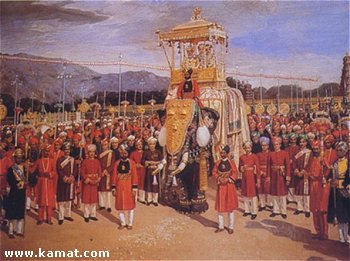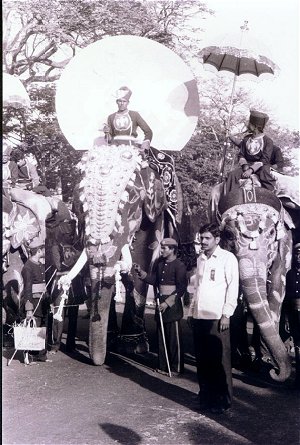The Elephants of Mysore Dasara
Research and Kannada Original by Mallikarjuna D.G.
Excerpted and Translated by Vikas Kamat
Pictures by K. L. Kamat
First Online: October 13, 2002
Page Last Updated: December 07, 2024
Introduction
The Dasara Festival celebrated in the city of Mysore is of legendary magnificence and splendor. It is a celebration that has continued from the grandeur of the days of the Wodeyar kings. These days, in the democratic India, there are no kings (only king's relatives), but the show goes on. The elephants are an integral part of the celebration, and here is a brief introduction to the elephants of Mysore Dasara.
© K. L. Kamat

An Elephant Pulling a Car
From a Painting on Mysore Palace
© K. L. Kamat

The King Riding the Elephant
Detail from painting of a Darasa Procession
The participation of elephants is central to the Dasara festivities at Mysore. The stories of Dasara elephants itself is a matter of great fascination for the local population. The participant elephants over the years, and especially the maitre-d-procession (or the lead elephant, last ones named Biligiriranga, Rajendra, Drona, and Balarama) have become part of history and folk legends.
Most of these Dasara-elephants were caught by the elephant trainers via the Khedda operation (see: Khedda System). During the Wodeyar rule, the elephants thus caught were inspected in an open field for strength, personality, and character. The walking styles, weaknesses to seduction, the facial charisma were some of the factors considered for selection. Then the chosen elephants were trained for the festival. It is said that the king himself would overlook the training.
Elephant Biligiriranga
Biligiriranga was majestic beast, about ten feet in height. The king Jayachamarajendra Wodeyar was very fond of this bull and would personally mingle with the elephant during Dasara. After the festivities, Biligiriranga would return to the forest and live there till the next Dasara. According to the forest officials, he was a virile bull and was responsible for increase in the elephant population in the area. There is no doubt that Biligiriranga increased the glory of the festival in Mysore. It is said that he was loyal and obedient to his trainer (mahut) till his death.
Elephant Rajendra
Rajendra was caught in the year 1971, and was the last to serve the Wodeyar dynasty. Soon after Indira Gandhi annulled all royalty in India, instead of the king, an idol of Goddess Chamundi was paraded during the procession, so Rajendra also had to adjust to the changing times moving from royal patronage to that of a public government.
Rajendra was a soft bull. He was easily influenced by presence of cow elephants. His trainers felt that Rajendra never found true love and sought for a soul-mate till his demise.
Elephant Drona
Drona was named after Dronacharya, the great guru of Mahabharata. In the epic, Dronacharya is a priest, but he was so mature and intelligent that he taught warfare for a livelihood! The elephant Drona was named so because of his amazing ability to learn and correct himself. When the ambari (the golden platform carrying the idol, a.k.a. howdah) shifted left or right during the procession, Drona could move his muscles selectively and stabilize the weight! His trainers were very surprised because they had not trained Drona in this skill. Drona also practiced energy conservation techniques (he would walk slow early in the procession to conserve energy), and rigid eating habits (he was very particular about his diet, and always ate in solitude). Drona led a durable family life with his two wives Kokila and Shanti.
One day Drona went grazing in a village of Balle and pulled down a trunk of a tree to eat the leaves. The falling trunk also brought down a high-tension power cable and instantly electrocuted the celebrated bull. Drona was mourned in the state just like any other celebrity.
Elephant Arjuna
It is a common practice to groom a descendant to the lead elephant even when the lead elephant is alive. Arjuna was the elephant thus trained to succeed Drona. One day Arjuna went to bathe in a river with his buddy Bahadur and Bahadur's trainer Annayya. While crossing a road, the elephants were startled by a vehicle and in the chaos that ensued, the rider Annayya fell down to the ground, only to be stamped on the his head by Arjuna. He was crushed to death. People opined that an elephant that had killed a man was unfit to carry the religious duties of Dasara. So Arjuna, while being as capable as Drona, never got to be the bearer of the prestige. These days he helps the forest officials trace poachers in the Bandipur National forest. The tragedy has has no apparent impact on him, but the people are not accepting him.
Elephant Balarama
After the Arjuna was voted out of Dasara lineup, Balarama, a bull of about forty years of age, who was captured in a forest near Somavarpet has been tapped for the festival. While he lacks the charisma of Drona and Arjuna, it is said that he is a dependable elephant. He is said to be an introvert, and had to be provided special training so he can withstand the firing of canons that occurs during the festival.
© K. L. Kamat

Mysore Dasara Procession
Decorated elephants waiting their turn to walk the procession.
Other Elephants
Altogether thirteen elephants participated in the festival. Each one of them has to go through a rigid conditioning. At least two of them have to be female. The chief elephant is followed by a row of five elephants. There is one elephant dedicated to pull the chariot containing Karnataka police band. There are a lot of stories about the companion elephants as well. Some anecdotes:
- A bull elephant Bharat is being groomed as an alternative to Balarama. He still is a youngster. He has good height and gracious walk, but lacks the sophistication. In a couple of years, he will be ready.
- Gajendra is an expert in elephant fighting. They still use him to capture other wild elephants. One day they were chasing a wild elephant in the forest, but Gajendra gave up the chase at one particular spot. When people gathered, they discovered a man fallen unconscious at the spot. Gajendra had let go of wild elephant, but had saved a man.
- Another elephant, Mahendra was very fond of his mahut (trainer). Apparently the trainer was a drunkard, and every night Mahendra would go in search of his trainer and bring him back from the village taverns.
- All the elephants arrive for the festival in huge trucks, but Arjuna refused any kind of ride. Hence he has to walk all the way from forest to Mysore.
![]()
See Also:
- Indian Elephants -- Section on the elephants of India explores their use in temples, as work-force, and their role in Indian society; includes a FAQ and a number of pictures.
- Dasara Festival -- Pictorial exhibition of celebration of Dasara festival in different parts of India, especially in Mysore.
- "Don't Scorn the Elephant Dung!"
- Mysore Collection -- Pictures and artifacts from the old Mysore kingdom. Includes pictures of Mysore city, its museums, and gardens.
- Buy on Amazon.com

